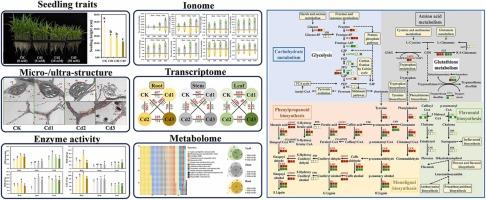Integration of comparative cytology, ionome, transcriptome and metabolome provide a basic framework for the response of foxtail millet to Cd stress
IF 12.2
1区 环境科学与生态学
Q1 ENGINEERING, ENVIRONMENTAL
引用次数: 0
Abstract
Apart from directly affecting the growth and development of crops, Cd in the soil can easily enter the human body through the food chain and pose a threat to human health. Therefore, understanding the toxicity of Cd to specific crops and the molecular mechanisms of their response to Cd is essential. In this study, hydroponic experiments were utilized to study the response of foxtail millet to Cd stress through phenotypic investigation, enzyme activity determination, ultrastructure, ionome, transcriptome and metabolome. With the increase in cadmium concentration, both the growth and photosynthetic capacity of foxtail millet seedlings are severely inhibited. The ultrastructure of cells is damaged, cells are deformed, chloroplasts swell and disappear, and cell walls thicken. Cd stress affects the absorption, transport, and redistribution of beneficial metal ions in the seedlings. Multi-omics analysis reveals the crucial roles of glycolysis, glutathione metabolism and phenylpropanoid and lignin biosynthesis pathways in Cd detoxification via energy metabolism, the antioxidant system and cell wall changes. Finally, a schematic diagram of foxtail millet in response to Cd stress was we preliminarily drew. This work provides a basic framework for further revealing the molecular mechanism of Cd tolerance in foxtail millet.

求助全文
约1分钟内获得全文
求助全文
来源期刊

Journal of Hazardous Materials
工程技术-工程:环境
CiteScore
25.40
自引率
5.90%
发文量
3059
审稿时长
58 days
期刊介绍:
The Journal of Hazardous Materials serves as a global platform for promoting cutting-edge research in the field of Environmental Science and Engineering. Our publication features a wide range of articles, including full-length research papers, review articles, and perspectives, with the aim of enhancing our understanding of the dangers and risks associated with various materials concerning public health and the environment. It is important to note that the term "environmental contaminants" refers specifically to substances that pose hazardous effects through contamination, while excluding those that do not have such impacts on the environment or human health. Moreover, we emphasize the distinction between wastes and hazardous materials in order to provide further clarity on the scope of the journal. We have a keen interest in exploring specific compounds and microbial agents that have adverse effects on the environment.
 求助内容:
求助内容: 应助结果提醒方式:
应助结果提醒方式:


